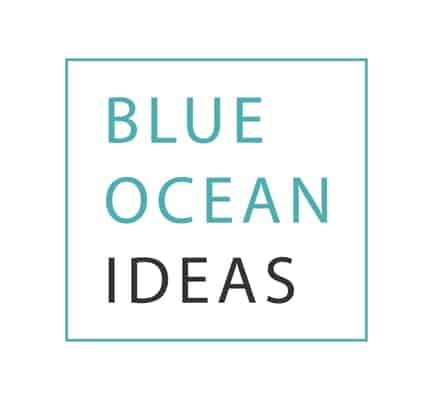Six Paths to Discovering a Blue Ocean Business Idea
Blue ocean ideas are prolific and there are more just waiting to be discovered. But finding them is often like a trying to find a specific shell on a huge beach. Commercially compelling blue ocean ideas are surrounded by cool but unprofitable ideas, red ocean ideas and some truly awful ones.
There are six methods that can be used to sift viable blue ocean ideas from the random tangle of possibilities.[1] Business owners should be prepared to begin with the end in mind when building-out business strategies.
That is, the truly great ideas are followed by a clear path toward selling the business through a merger or acquisition at some point in the future.
Method 1: Look Across Alternative Industries
Companies compete with other firms in its own industry and with companies in other industries that create alternate products. To clarify, an alternate product or service is not a substitute product (something that functionally does the same thing as the good or service in question). Alternative products or services have different forms but offer the same basic functionality as the product or service being examined. For example, to relax after work a person could get a massage, go to the gym, solve a crossword puzzle, or have a beer with friends. These four products or services can be used by a person to relax, yet they are very different from one another. They each offer alternative methods of accomplishing the same basic thing – relaxing after work.
Looking across alternative industries can offer insights into how you can create a new value proposition that accomplishes the objective of two or more industries products or services. An example is NetJets, which offers customers fractional ownership in private jets. NetJet’s value proposition is offering customers the advantages of private jet travel (no security check in, comfort, speed, non-stop flights) for a fraction of the cost of owning an maintaining a private jet. NetJets was able to create a value proposition by blending two alternative methods of luxury aviation travel – first class travel via commercial airlines and private jets.

Method 2: Look Across Strategic Groups within Industries
Companies that operate within the same industry often pursue similar business strategies. A cluster of companies within an industry that pursue similar strategies are called strategic groups. There are usually two general types of strategic groups within any given industry – companies that pursue a low price strategy and those that pursue performance. Companies within strategic groups tend to directly compete against each other while ignoring those companies other strategic groups because their value propositions cater to different market segments.
A blue ocean idea can be created by understanding why certain customer segments choose one of the industry’s strategic groups over another, then creating a customized value proposition from select factors that appeal to a certain customer segment. By understanding the wants and needs of a customer segment, you can either 1) raise or create strategic group factors that are important to that market segment while 2) lowering or eliminating those factors that are irrelevant to the market segment.
An in depth example of looking across strategic groups within industries for CrossFit – a blue ocean idea for a fitness gym – can be viewed here.
Method 3: Look Across the Chain of Buyers
A group of buyers for products and services can be divided into three categories – purchasers, users, and influencers.[2] Purchasers actually buy the products or services in question. Users are the people who actually use or consume the products or services bought by the purchasers. Influencers are people who steer purchasers toward one product or service over another.
Sometimes these categories can overlap and the purchaser, user and influencer can be one person. An example would be a person who chooses to eat at a particular restaurant because they really like the food. But often these categories may consist of separate groups of people. The purchasers who pay for a product or service may differ from actual users. A government procurement officer may seek out the lowest cost product alternative, while the government employee who uses the product desires to use the best quality product available. Also, influencers can trigger buying decisions by purchasers. A child who likes sugary cereal can pester his parents into purchasing it. Without the child’s input, the parents may never have thought to purchase a particular brand of sugary cereal.
Companies will often concentrate their sales channels on one of these categories – purchasers, users, or influencers. A strong economic rationale may exist for a company to do this, but often the focus on one category of a buyer group is the result of an industry practice that has never been questioned.[3]
An example of this is Novo Nordisk.[4] Novo Nordisk makes insulin for diabetic patients. Historically, insulin was injected into patients using syringes. Therefore, insulin producers concentrated their marketing efforts on one category within their target buyer group – doctors. Then Novo Nordisk invented the NovoPen, a much easier way for insulin patients to inject their insulin treatments than using syringes. Novo Nordisk then developed a blue ocean strategy to market the NovoPen directly to users – the patients. This transformed the insulin industry and allowed Novo Nordisk to dominate the diabetes care market.
 Method 4: Look Across Complimentary Product and Service Offerings
Method 4: Look Across Complimentary Product and Service Offerings
The value of products and services are often affected by other products and services. The purpose of looking across complimentary product and service offerings is to define a total solution buyers seek by thinking about what happens before, during, and after you use a product or service.[5] The key is to identify and eliminate buyers’ pain points through a complimentary product or service offering.
An example of using complimentary product and service offerings as a blue ocean strategy is Barnes and Noble. They chose to not just sell books, but provide a myriad of services that book buyers wanted – reading areas, a knowledgeable staff and coffee bars to create an environment that book buyers found appealing.[6] Barnes and Noble knew that book buyers enjoyed browsing for books before purchasing them, and they constructed their store experience to compliment that habit.
Method 5: Look Across Functional or Emotional Appeal to Buyers
Companies within industries often compete on one of two possible types of customer appeal – rational and emotional.[7] If customers’ take a rational approach to purchasing a product or service, the product’s price, function and utility are the customers’ key decision factors. If customers’ key decision factor in purchasing an industry’s product or service, that purchase decision is driven by emotions.
Most companies within an industry cater to some general area along the rational/emotional purchase decision spectrum. For example, purchasing gasoline is mostly marketed by oil companies as a rational choice for consumers (price, function, results). This type of “herd” marketing educates and reinforces consumers as to what kind of future marketing to expect from that industry. It can become a self-fulfilling cycle, giving consumers what they expect after already shaping their expectations.
New market space can sometimes be found when a company shifts from one end of the functional-emotional spectrum to the other. An example of this is Starbucks. Before Starbucks came along, coffee tended to be a commodity product sold in bulk cans to consumers or served brewed at truck stops and diners. Starbucks had the insight to turn getting coffee into an emotional experience by having baristas prepare customized coffee drinks right in front of the customer. Also, Starbucks sought to turn their cafes into a unique place where customers can relax, drink their coffee and forget about the stresses of life at home or work. By creating an emotional connection between customers and their coffee, Starbucks elevated what was a commodity product into a small luxury. This doubled or tripled the price consumers were willing to pay by turning simple coffee into a coffee experience.
Method 6: Look Across Time
This approach involves looking for irreversible external macro trends and attempting to shape their trajectory over time. The key to using this approach is identifying a major macro trend affecting a given industry that has a relatively clear trajectory, then creating new products and services to capitalize on this trend.[8] These macro trends may be economic, social, regulatory, political, or technological in nature. Examples of companies that have used this approach are Apple’s iTunes (internet delivered music), CNN (globalization), and Cisco (growing demand for high-speed data exchange).[9]
Nate Nead is an investment banker with InvestmentBank.com. He works with clients who are looking to sell their business via strategic mergers & acquisitions. In addition, he assists firms who may be looking to raise capital or otherwise recapitalize their businesses with strategic growth partners. He resides in Seattle, Washington.


